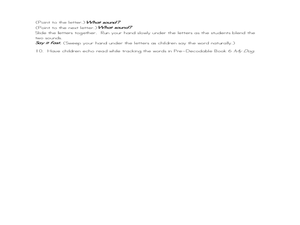Florida Center for Reading Research
Phoneme Split and Say
Little ones are provided with all the tools needed to begin segmenting phonemes. There are twenty Elkonin box picture cards, five blank Elkonin box cards, and full instructions on how to help pre-readers practice splitting and saying...
Curated OER
Shhhhhhh! The sheep are sleeping!
Pupils examine the use of /sh/ in written and spoken words by watching how their mouth moves while making the sound, identifying words, listening to a story, and making words with Elkonin letterboxes. As an assessment, they complete a...
Curated OER
Segmenting and Blending Words
Students are introduced to the concept of segmentation and blending of words. As a class, they are shown various words and are asked to determine the amount of letters and sounds in each. To end the lesson, they participate in a...
Curated OER
Segmenting and Blending Words
Students listen to words, then segment them into sounds, and hear sounds and blend them into words.
Curated OER
Small Group: BL
Practice target sounds, especially the /a/ sound. The teacher first speaks and learners repeat words, discriminating between words with varying sounds after focusing on /a/. Letter cards are held up to show the symbolic representation of...
Curated OER
I Said a Boom Chicka Boom
Young scholars explore how to blend words. They distinguish phonemes and practice blending them. Students practice the /oo/ sound and identify words that contain that sound. They read Chicka Chicka Boom Boom and identify words that have...
Florida Department of Education
Phonemic Awareness
Build your library of strategies and activities for teaching phonemic awareness with the ideas provided in this resource. Described here are five different activities to try out with your class.
Curated OER
Shh, Do Not Wake the Baby!
Students explore the /sh/ digraph and how it is a blending of the /s/ and /h/ sounds. They use letterbox manipulatives to spell 'sh' words and identify /sh/ words as they read a story. They 'fish' for 'sh' words to practice writing at...
Curated OER
Say Aaaaa for Apple
Young scholars say words by blending sounds and phonemes. They decode words in order to read and identify and understand the letter a. This phoneme /a/ is one of the short vowels that are needed to read and write. They will show...
Curated OER
Boom Chicka Boom
Learners recognize how vowel patterns change a short vowel sound into a long vowel sound. With an emphasis on the /oo/ that makes the long U sound, students identify the phoneme and letter combination through listening and matching...
Curated OER
Sh Sh Sh: The Baby is Sleeping
Learners work with the /sh/ digraph. They read and spell words that contain the phoneme /sh/. Students read Sh!Sh! Stop that Noise. They identify the words containing the phoneme /sh/ while reading the story. Learners practice spelling...
Curated OER
Say aahhh....said the doctor
Pupils recognize the short vowel O in written and spoken language. Through matching activities, they discriminate the short vowel /o/ from other vowel sounds. Students associate the phoneme with its letter representation and identify the...
Curated OER
Ugh!
First graders focus on the phoneme /u/. They make the sound and say "Ugh" and pronounce other words that contain the /u/ sound such as tub. They then repeat a tongue twister featuring the /u/ sound breaking the sound off each word and...
Curated OER
The Squeaky Creaky Elevator
Young scholars engage in an emergent literacy lesson in order to help develop the skills of letter recognition and corresponding sound of the phoneme. This is done with the use of a tongue twister using the phoneme of the letter "e".















